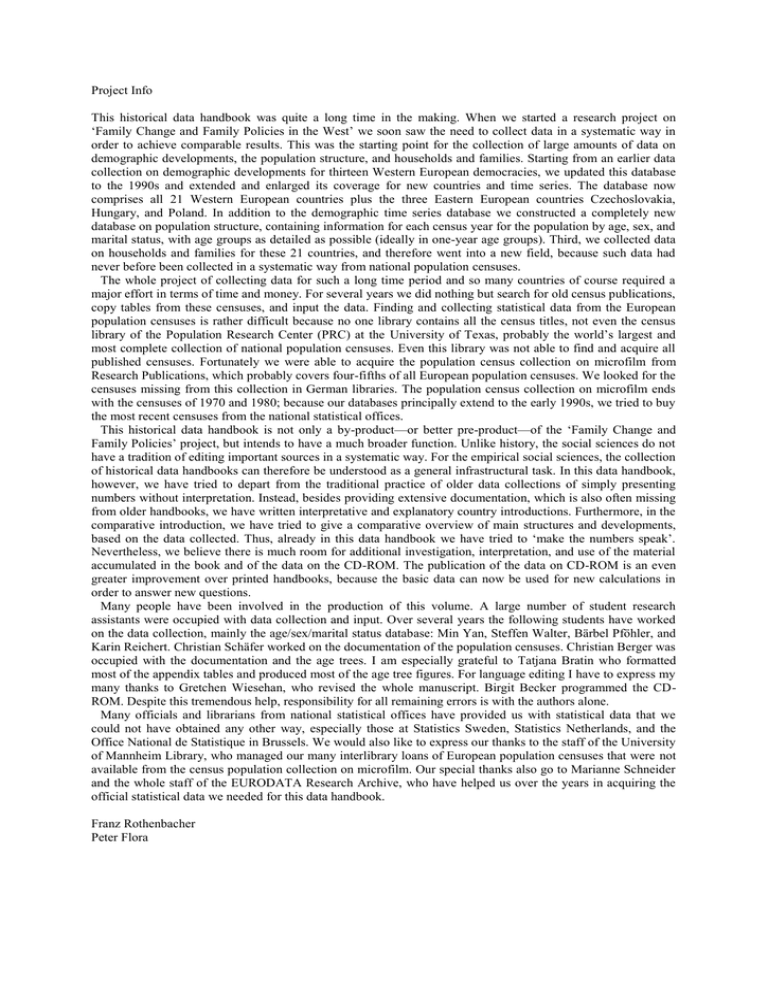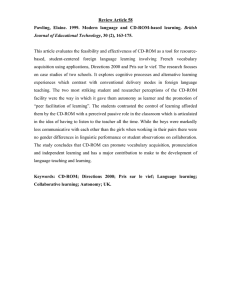Project Info
advertisement

Project Info This historical data handbook was quite a long time in the making. When we started a research project on ‘Family Change and Family Policies in the West’ we soon saw the need to collect data in a systematic way in order to achieve comparable results. This was the starting point for the collection of large amounts of data on demographic developments, the population structure, and households and families. Starting from an earlier data collection on demographic developments for thirteen Western European democracies, we updated this database to the 1990s and extended and enlarged its coverage for new countries and time series. The database now comprises all 21 Western European countries plus the three Eastern European countries Czechoslovakia, Hungary, and Poland. In addition to the demographic time series database we constructed a completely new database on population structure, containing information for each census year for the population by age, sex, and marital status, with age groups as detailed as possible (ideally in one-year age groups). Third, we collected data on households and families for these 21 countries, and therefore went into a new field, because such data had never before been collected in a systematic way from national population censuses. The whole project of collecting data for such a long time period and so many countries of course required a major effort in terms of time and money. For several years we did nothing but search for old census publications, copy tables from these censuses, and input the data. Finding and collecting statistical data from the European population censuses is rather difficult because no one library contains all the census titles, not even the census library of the Population Research Center (PRC) at the University of Texas, probably the world’s largest and most complete collection of national population censuses. Even this library was not able to find and acquire all published censuses. Fortunately we were able to acquire the population census collection on microfilm from Research Publications, which probably covers four-fifths of all European population censuses. We looked for the censuses missing from this collection in German libraries. The population census collection on microfilm ends with the censuses of 1970 and 1980; because our databases principally extend to the early 1990s, we tried to buy the most recent censuses from the national statistical offices. This historical data handbook is not only a by-product—or better pre-product—of the ‘Family Change and Family Policies’ project, but intends to have a much broader function. Unlike history, the social sciences do not have a tradition of editing important sources in a systematic way. For the empirical social sciences, the collection of historical data handbooks can therefore be understood as a general infrastructural task. In this data handbook, however, we have tried to depart from the traditional practice of older data collections of simply presenting numbers without interpretation. Instead, besides providing extensive documentation, which is also often missing from older handbooks, we have written interpretative and explanatory country introductions. Furthermore, in the comparative introduction, we have tried to give a comparative overview of main structures and developments, based on the data collected. Thus, already in this data handbook we have tried to ‘make the numbers speak’. Nevertheless, we believe there is much room for additional investigation, interpretation, and use of the material accumulated in the book and of the data on the CD-ROM. The publication of the data on CD-ROM is an even greater improvement over printed handbooks, because the basic data can now be used for new calculations in order to answer new questions. Many people have been involved in the production of this volume. A large number of student research assistants were occupied with data collection and input. Over several years the following students have worked on the data collection, mainly the age/sex/marital status database: Min Yan, Steffen Walter, Bärbel Pföhler, and Karin Reichert. Christian Schäfer worked on the documentation of the population censuses. Christian Berger was occupied with the documentation and the age trees. I am especially grateful to Tatjana Bratin who formatted most of the appendix tables and produced most of the age tree figures. For language editing I have to express my many thanks to Gretchen Wiesehan, who revised the whole manuscript. Birgit Becker programmed the CDROM. Despite this tremendous help, responsibility for all remaining errors is with the authors alone. Many officials and librarians from national statistical offices have provided us with statistical data that we could not have obtained any other way, especially those at Statistics Sweden, Statistics Netherlands, and the Office National de Statistique in Brussels. We would also like to express our thanks to the staff of the University of Mannheim Library, who managed our many interlibrary loans of European population censuses that were not available from the census population collection on microfilm. Our special thanks also go to Marianne Schneider and the whole staff of the EURODATA Research Archive, who have helped us over the years in acquiring the official statistical data we needed for this data handbook. Franz Rothenbacher Peter Flora User Information Contents of the CD-ROM The CD-ROM provides data and documentation on demographic developments, population and household structures in Western and East-Central Europe. Four main aspects are covered: population structure and density, vital statistics, life expectancy, and households and families. Tabular data are provided in MS-EXCEL and, alternatively, as print-files (PDF). Documentation is displayed in HTML-format. To make proper use of the CD-ROM, users are asked to consult the handbook. The CD-ROM is a supplement to the handbook, not a substitute. The documentation on the CD-ROM is much more condensed and summary than the documentation in the handbook. On the other hand, the CD-ROM includes all the handbook tables in machine readable form and in addition a wealth of supplementary data not available in the handbook. Navigation through the CD-ROM Navigation is straight-forward: users can follow the instructions appearing on the screen and select the preference by clicking on the buttons and links. Display, browsers, and programmes The display and retrievement of information depends on the configuration of the PC, more specifically on the type of browser (Netscape, Microsoft Internet Explorer, etc.), and available programmes. These factors may influence the quality of access to the information. If properly installed, when clicking to load data into MSExcel, these programmes are started and the files are opened. By using Netscape, when clicking to view the documentation (PDF files), a second Netscape window is opened and the file appears in Acrobat Reader. In the case the programmes are not started, check whether they are installed as Applications in the Preferences of Netscape. By using Microsoft Internet Explorer, when clicking to load data into MS-Excel, the Excel programme is started but the Microsoft Internet Explorer toolbar still appears at the top of the screen. To return to the CD-ROM users can click on the Back button of the toolbar. By viewing the documentation (PDF files), a second Microsoft Internet Explorer window is opened and the file appears in Acrobat Reader. Further help By persistent problems in opening and viewing the data, users are adivised to check whether programmes are installed correctly and to consult their computer administrator. For further help users can also refer to the buttons on: On-line Information. On-line Information Users are supported via FAQs (answers to frequently asked questions) at http://www.mzes.uni-mannheim.de/eurodata/population1_cd. To ask a question that cannot be solved by consulting the configuration help on CD, users can e-mail to population1@mzes.uni-mannheim.de. No direct individual replies are given. Instead, the answer appears in the FAQ-section, if the problem is new. Configuration Configuration of the screen The display of information provided by the CD-ROM is optimal with a screen size of 17 inches and a resolution of 1024 x 768 pixels. With a screen size of 17 inches, users are advised to choose the option Small Characters in the Control Panel (Display - Setting) in the Windows environment. The font size in the Netscape Communicator configuration (choose Preferences - Appearance - Fonts) should not exceed 12 points. Browsers The CD-ROM has been developed for Netscape 4.X but it can also be run with Microsoft Internet Explorer 4.X and other browsers supporting Frames, JavaScript, and Style Sheets. Configuration of Netscape 4.X To use the CD-ROM, the pre-configuration of Netscape can be left unmodified. However, users are advised to verify the correct configuration with regard to two points. The configuration of Netscape 4.X can be verified and possibly modified through the Edit menu (Preferences). 1.Choose Advanced to make sure that the following points are selected: Automatically load images Enable Java Enable JavaScript Enable Style Sheets 2.If you wish to use the data in MS-Excel, MS-Access or DBASE, as well as the print tables (PDF files), choose Navigator - Applications to make sure that these programs appear in the Description list: Excel (XLS) Acrobat Reader (PDF) In case one of these applications does not appear in the Description list, it is possible to add them through the New Type button and configurate them through the Edit button. If required, ACROBAT READER can be installed from the CD-ROM (cf. directory 'setup'). Application releases The following minimal releases of the applications are necessary to use the data: Excel, release 5.0 Acrobat Reader, release 4.0 Servers Users are advised to check the configuration of the server to make sure that MS Excel files appear correctly.

